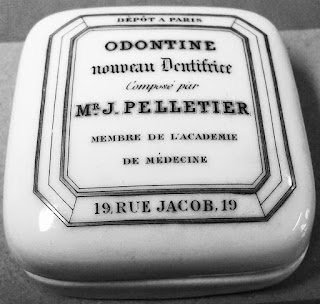Different recipes for products meant to clean and whiten the teeth and to freshen the breath are known ever since Classical Antiquity. The Greeks and the Romans often used dentifrices (tooth powders) made of burnt and finely crushed bones and shells, sometimes mixed with honey and various astringent substances (such as myrrh).
Pharmacists prepared such products from the end of the Middle Ages and until the beginning of the twentieth. The recipes are mentioned in the different specialized works and the products are a constant presence in the Materia medica.
Dentifrices are defined as mechanical cleaning agents, usually powders, for the cleaning of teeth, usually made of the following main ingredients:
- Pumex - pumice stone
- Bolus Armeniaca - red clay
- chalk
- Ossae Sepiae - cuttlefish bone
- Myrrha - myrrh
- Iridis Florentinae Radix - Iris bulb
- Catechu - acacia extract
- Sanguis Draconis - the resin of certain wild palm trees
Some of the ingredients were used for their roughness, others for their astringent properties (addressing certain gum issues), while yet other for their nice smell, aimed at freshening one's breath. These types of ingredients had to be carefully balanced, so as to clean efficiently but not affect the enamel.
The History of Pharmacy Collection in Cuj-Napoca includes a series of containers for dentifrices, made of wood, glass and porcelain. Three of the items are wooden apothecary jars used during the nineteenth century in a pharmacy from Baia Mare, with painted signatures that indicate the type of product contained: "Pulv(eris) Dentifr(icium) Alb(um) and "Pulv. Dentif. Rub(rum)" thus differentiate between red and white tooth powders. "Pulv. Dentif' "Sipos"" probably refers to a special recipe, bearing the name of its inventor. Another apothecary jar, made of milky glass, dated to the nineteenth century, has the signature "Pulv. Dentif. Huf." and is part of the old Orient collection.
The last two items are rectangular cases for tooth powder produced in Paris. One of them is made of porcelain, was obtained from the "Crown" Pharmacy in Iasi and the markings on the lid provide a series of clarifications. "Odontine" was a recipe launched in 1860 by chemist J. Pelletier, member of the French Academy of Medicine, at the suggestion of a dentist-surgeon colleague. The composition of this tooth paste was aimed at counteracting oral acidity, as a way to prevent the formation of cavities. The second box, made of milky glass, produced by the Bigaud company in Paris contained another tooth paste. The lid is marked "Pate dentifrice Bigaud Paris". The item is part of the old Orient Collection, thus not much is known on where it was sold in Transylvania.
The History of Pharmacy Collection in Cuj-Napoca includes a series of containers for dentifrices, made of wood, glass and porcelain. Three of the items are wooden apothecary jars used during the nineteenth century in a pharmacy from Baia Mare, with painted signatures that indicate the type of product contained: "Pulv(eris) Dentifr(icium) Alb(um) and "Pulv. Dentif. Rub(rum)" thus differentiate between red and white tooth powders. "Pulv. Dentif' "Sipos"" probably refers to a special recipe, bearing the name of its inventor. Another apothecary jar, made of milky glass, dated to the nineteenth century, has the signature "Pulv. Dentif. Huf." and is part of the old Orient collection.
 |
| Red dentifrice preserved in one of the apothecary jars |
 |
| Odontine container preserving the original tooth paste |
The last two items are rectangular cases for tooth powder produced in Paris. One of them is made of porcelain, was obtained from the "Crown" Pharmacy in Iasi and the markings on the lid provide a series of clarifications. "Odontine" was a recipe launched in 1860 by chemist J. Pelletier, member of the French Academy of Medicine, at the suggestion of a dentist-surgeon colleague. The composition of this tooth paste was aimed at counteracting oral acidity, as a way to prevent the formation of cavities. The second box, made of milky glass, produced by the Bigaud company in Paris contained another tooth paste. The lid is marked "Pate dentifrice Bigaud Paris". The item is part of the old Orient Collection, thus not much is known on where it was sold in Transylvania.
 |
| 19th-century Odontine commercial (French) |






No comments:
Post a Comment